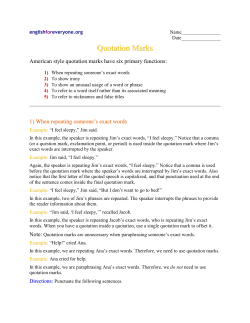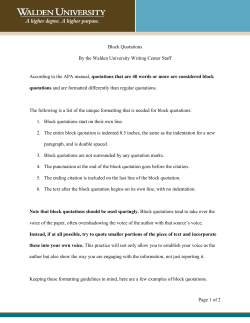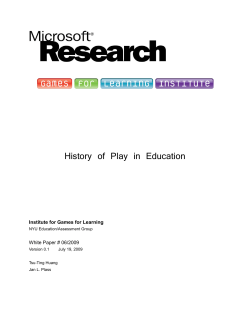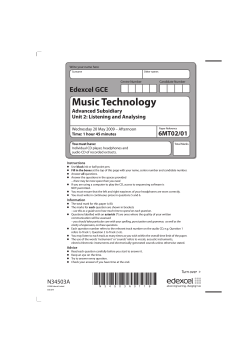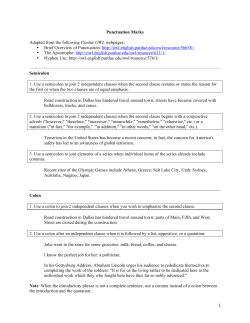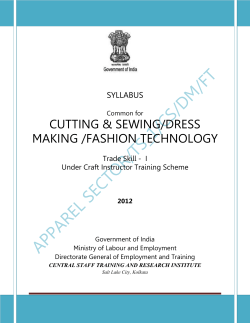
‘Using quotation marks’ How quotation marks are used in writing
‘Using quotation marks’ How quotation marks are used in writing Quotation marks are used for a variety of reasons. They are used to show the exact words someone has spoken or written (a direct quote), or to identify specialist terms. They may also be used to draw attention to words or phrases. Quotation marks are particularly important when referencing because they indicate when someone else’s exact words are being used. This pamphlet will provide examples of how quotation marks are used in different situations, and provides a short quiz for you to test your knowledge of quotation marks. Variations – ‘single’ or “double”? Quotation marks can be ‘single’ or “double”. In Australia, there is a preference for single quotation marks, however, you should check which type the style guide in your faculty recommends. The placement of quotation marks in relation to punctuation, such as full-stops, exclamation points and question marks, also varies. North America and Britain follow different conventions. Australia most commonly follows the British practice, but usage can depend on the publication and the style guide it uses. It is recommended that you use single quotation marks to indicate direct quotes unless your faculty style guide states otherwise. Short and long quotations Short quotes are usually placed directly in the text, with quotation marks at their beginning and end. When using a quote that is longer than 40 words, start the text on a new line and indent slightly. The font in such a quotation is usually smaller than the surrounding text (for example, size 11 instead of 12). Do not use quotation marks. The following is an example of a block quotation. Quotation marks are also called quote marks, quotes or speech marks; they used to be called inverted commas but that term appears to be falling out of favour. Their primary function is to show direct speech and the quoted work of other writers. Other uses are for enclosing the title of a song or an article in a periodical, and for drawing attention to a term that is unusual or recently coined (Commonwealth of Australia: 2002. p. 25). www.services.unimelb.edu.au/academicskills Examples of quotation usage 1. Use quotation marks to enclose direct quotations: ‘My house!’ he cried, ‘My house is burning!’ However, don’t use quotation marks with indirect quotes or when paraphrasing. She said that she remembered how ‘he cried for his house’. She said that she remembered how he cried for his house. 2. Use double quotation marks (or single marks if you normally use double marks) to enclose a quote within a quote: ‘I remember’, she said, ‘how he cried “My house!”’ 3. Use commas to introduce direct quotes: In her article, Bektovic (2005, p. 3) maintains, ‘The decision not to ratify the Kyoto Protocol will harm the Australian economy’. However, do not use commas: for quotes introduced by ‘that’ for ‘integrated’ quotes where the quote fits smoothly into the text . Bektovic (2005, p.3) believes that, ‘the decision […] will harm the Australian economy’. Bektovic (2005, p.3) believes that ‘the decision […] will harm the Australian economy’. Brown (1997, p.84) describes the results as, ‘unreliable and insignificant’. Brown (1997, p.84) describes the results as ‘unreliable and insignificant’. 4. Use full-stops carefully with quotation marks: If the quotation is not a full sentence (see next page examples one and two), no comma is placed before the quotation mark. However, if the quotation is a full, selfcontained sentence without any ‘he said’ or other carrier expression (examples three and four), the full stop is placed before the closing quotation mark. Academic Skills • 13 MELB • Go for excellence academic-skills@unimelb.edu.au Evans defines referencing as ‘the labelling of material you have drawn from other writers with enough information for the reader to be able to locate the source’ (1995, p. 52). Sources are detailed in a reference list and ordered according to ‘order of appearance’. A short quiz Add the quotation marks and any other punctuation that is needed in the following questions. Attempt to answer these questions before checking the answers at the bottom of this page. The lecturer said, ‘The purpose of this paper is to present your argument.’ 1 Do you know Dorothy Porter's poem The Ninth Hour she asked. ‘The purpose of this paper is to present your argument.’ 2 Of all the poems in her latest book she said this is the best. It's very dramatic she added 3 Lee's lecturer asked him why he hadn’t handedin his assignment. 5. Keep the punctuation as part of the quotation if it was originally part of the quotation: 4 Who said To be or not to be, that is the question asked Dr Meehan. ‘Are you going to hand in your assignment tomorrow’? the lecturer asked. 5 In his article Punctuation Tips Smith discusses the importance of commas ‘Are you going to hand in your assignment tomorrow?’ the lecturer asked. 6 Turning towards his student, he said Don’t leave yet He was frowning and clearly disapproved of something 6. However, if the punctuation mark is not part of the original quotation, place it outside the quotation mark: 7 Why haven’t you referenced that book he asked 8 I forgot where I got the quote she answered Did you hear the professor say ‘Hooray for the holidays’? Further Resources Truss, L. (2003). Eats, shoots & leaves: the zero tolerance approach to punctuation. London: Profile Books. 7. Use single quotation marks to indicate that a word or phrase is used in a special way or that the word is the topic under discussion: Commonwealth of Australia. (2002). Style manual (6th ed). Australia: John Wiley and Sons. The term ‘proxemics’ was coined by anthropologist Edward T. Hall in 1963. McKenzie, M. (2001). Handbook for Writers and Editors. Melbourne: Dundas Press. These websites provide information and exercises on the use of punctuation marks: Four soldiers were killed by ‘friendly fire’. Capital Community College: http://grammar.ccc.commnet.edu/grammar/marks/marks.htm 8. Use quotation marks the first time a technical term is used in a document for a general audience: Online Writing Lab at OWL at Purdue University: The medical treatment of ‘androgen insensitivity syndrome’ is controversial. http://owl.english.purdue.edu/owl/resource/577/01 The Blue Book of Grammar and Punctuation: http://www.grammarbook.com/punctuation/quotes.asp 9. Use quotation marks to highlight a questionable concept: The government did not implement the ‘policy’ as they promised. 10. Use quotation marks for colloquial words in academic writing: The Australian student said she was a ‘fair dinkum Aussie’. www.services.unimelb.edu.au/academicskills Academic Skills • 13 MELB • Go for excellence V2 1012LS academic-skills@unimelb.edu.au
© Copyright 2025

